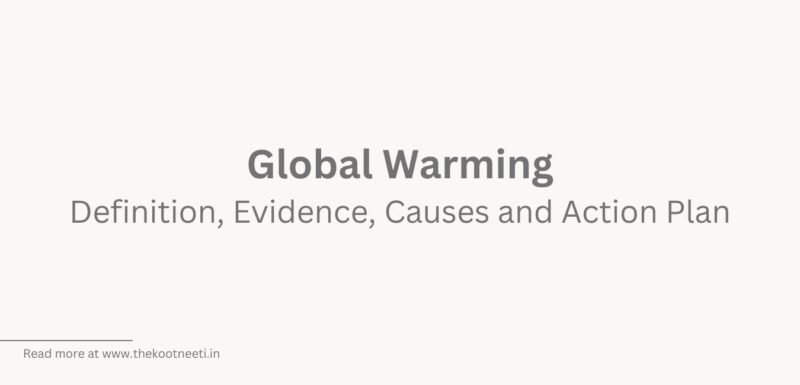Global Warming; Definition, Evidence, Causes and Action Plan

Global warming refers to the long-term warming of the planet caused by the increase in the concentration of greenhouse gases in the Earth’s atmosphere. Greenhouse gases, such as carbon dioxide, methane, and water vapor, trap heat from the sun and keep the planet warm. However, human activities, such as the burning of fossil fuels and deforestation, have led to an increase in the concentration of greenhouse gases in the atmosphere, which has contributed to the warming of the planet.
The evidence for global warming is overwhelming and comes from a variety of sources, including temperature records, melting ice caps, and rising sea levels. The impacts of global warming are already being felt around the world, and are likely to become more severe in the future. These impacts include more frequent and severe heatwaves, droughts, and storms, as well as rising sea levels and the loss of biodiversity.
Global warming is a major concern in international relations and global politics, as it has the potential to disrupt economic and social systems and to undermine global security. Efforts to address global warming, such as the Paris Agreement, have been a central focus of international cooperation and diplomacy.
Evidence of global warming
There is overwhelming evidence that global warming is occurring and that human activities are contributing to it. Some of the key pieces of evidence for global warming include:
- Rising temperatures: The Earth’s average surface temperature has increased by about 1.62 degrees Fahrenheit (0.9 degrees Celsius) since the late 19th century, with most of the warming occurring since the 1970s. This warming has been observed all around the world, and is likely to continue in the future.
- Melting ice: Global warming is causing the melting of the Earth’s ice caps and glaciers, which is contributing to rising sea levels. The Arctic sea ice has decreased by about 13% per decade since the 1980s, and the Greenland and Antarctic ice sheets are also losing mass.
- Rising sea levels: The melting of the Earth’s ice caps and the thermal expansion of seawater caused by rising temperatures are both contributing to rising sea levels. Sea levels have risen by about 8 inches (20 centimeters) since the late 19th century, and are likely to continue rising in the future.
- Changes in weather patterns: Global warming is causing changes in weather patterns around the world, including more frequent and severe heatwaves, droughts, and storms. These changes are having significant impacts on natural systems and human communities.
- Changes in biodiversity: Global warming is causing changes in the distribution and behavior of plants and animals, which is leading to the loss of biodiversity. Many species are struggling to adapt to changing conditions, and some are at risk of extinction.
Causes of Global Warming
- The burning of fossil fuels: The burning of coal, oil, and natural gas releases large amounts of carbon dioxide and other greenhouse gases into the atmosphere, which trap heat and contribute to global warming.
- Deforestation: Cutting down trees and other vegetation removes a natural sink for carbon dioxide, and the resulting decrease in vegetation can contribute to global warming.
- Industrial processes: Many industrial processes, such as cement production and waste disposal, release greenhouse gases into the atmosphere.
- Transportation: The use of cars, trucks, and airplanes that rely on fossil fuels also releases greenhouse gases into the atmosphere.
- Use of certain refrigerants: Some refrigerants, such as hydrofluorocarbons (HFCs), have a high global warming potential and can contribute to global warming if they are released into the atmosphere.
Steps to combat Global Warming
There are a number of steps that can be taken to combat global warming and reduce the greenhouse gas emissions that are contributing to it:
- Reduce energy consumption: One of the key ways to reduce greenhouse gas emissions is to use energy more efficiently and to reduce our overall consumption of energy. This can be done by using energy-efficient appliances, insulating buildings, and using public transportation or fuel-efficient vehicles.
- Use renewable energy: Another important step is to shift away from fossil fuels, which are a major source of greenhouse gas emissions, and towards renewable energy sources, such as solar, wind, and hydroelectric power.
- Protect forests and natural habitats: Deforestation and the destruction of natural habitats are major sources of greenhouse gas emissions. Protecting forests and other natural habitats can help to reduce these emissions and to absorb carbon dioxide from the atmosphere.
- Promote sustainable agriculture: Agriculture is a significant source of greenhouse gas emissions, particularly through the use of synthetic fertilizers and the production of livestock. Promoting sustainable agriculture practices, such as organic farming and regenerative agriculture, can help to reduce these emissions.
- Implement carbon pricing: Carbon pricing, such as a carbon tax or cap-and-trade system, can provide an economic incentive for businesses and individuals to reduce their greenhouse gas emissions.
- International cooperation: Addressing global warming will require international cooperation to reduce greenhouse gas emissions and to adapt to the impacts of climate change. This can be achieved through agreements such as the Paris Agreement, which aims to limit global warming to well below 2 degrees Celsius.


















